Charles Sturt University: ITC506 Early Launch Scenario Ethics Analysis
VerifiedAdded on 2021/04/16
|7
|2136
|77
Homework Assignment
AI Summary
This assignment analyzes an ethical dilemma presented in the "Early Launch" scenario, where a program director pressures a project manager to release software a month early, without encryption, due to CEO pressure. The project manager is reluctant due to the risks of data breaches and software crashes. The assignment addresses several key questions using the "Doing Ethics Technique," including the facts of the situation, the ethical issues involved (such as compromising security and bribery), the stakeholders affected (project manager, client, company), and the implications of the ethical issues. The analysis highlights how the program director's unethical actions, including threats and ultimately removing the project manager from the project, could have been avoided if he had considered the project manager's concerns and the potential reputational damage to the company. The assignment concludes by identifying and evaluating options, ultimately recommending that the program director should have listened to the project manager to mitigate the risk. The document also includes a detailed analysis of the ethical issues and provides references to support the arguments.
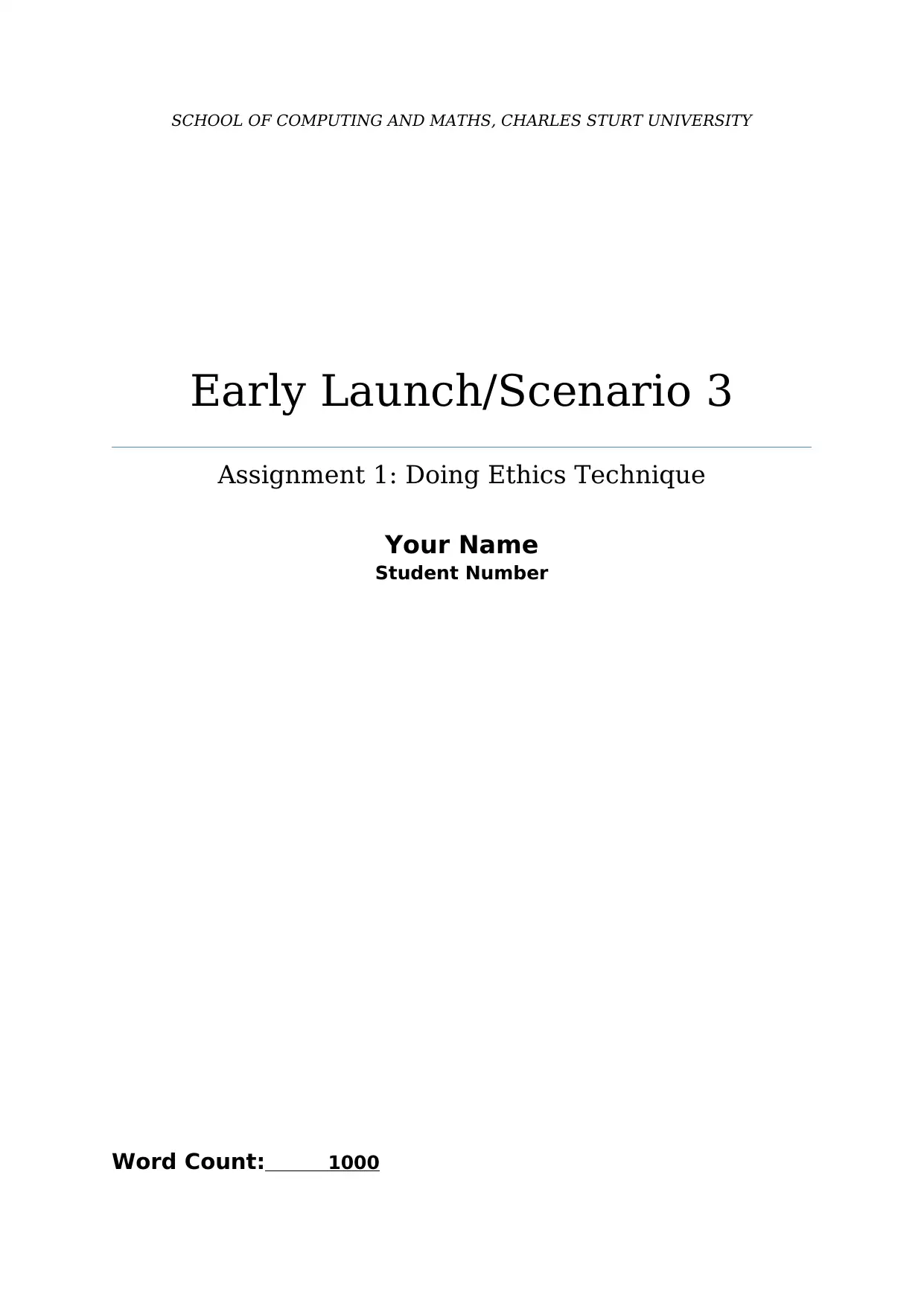
SCHOOL OF COMPUTING AND MATHS, CHARLES STURT UNIVERSITY
Early Launch/Scenario 3
Assignment 1: Doing Ethics Technique
Your Name
Student Number
Word Count: 1000
Early Launch/Scenario 3
Assignment 1: Doing Ethics Technique
Your Name
Student Number
Word Count: 1000
Paraphrase This Document
Need a fresh take? Get an instant paraphrase of this document with our AI Paraphraser
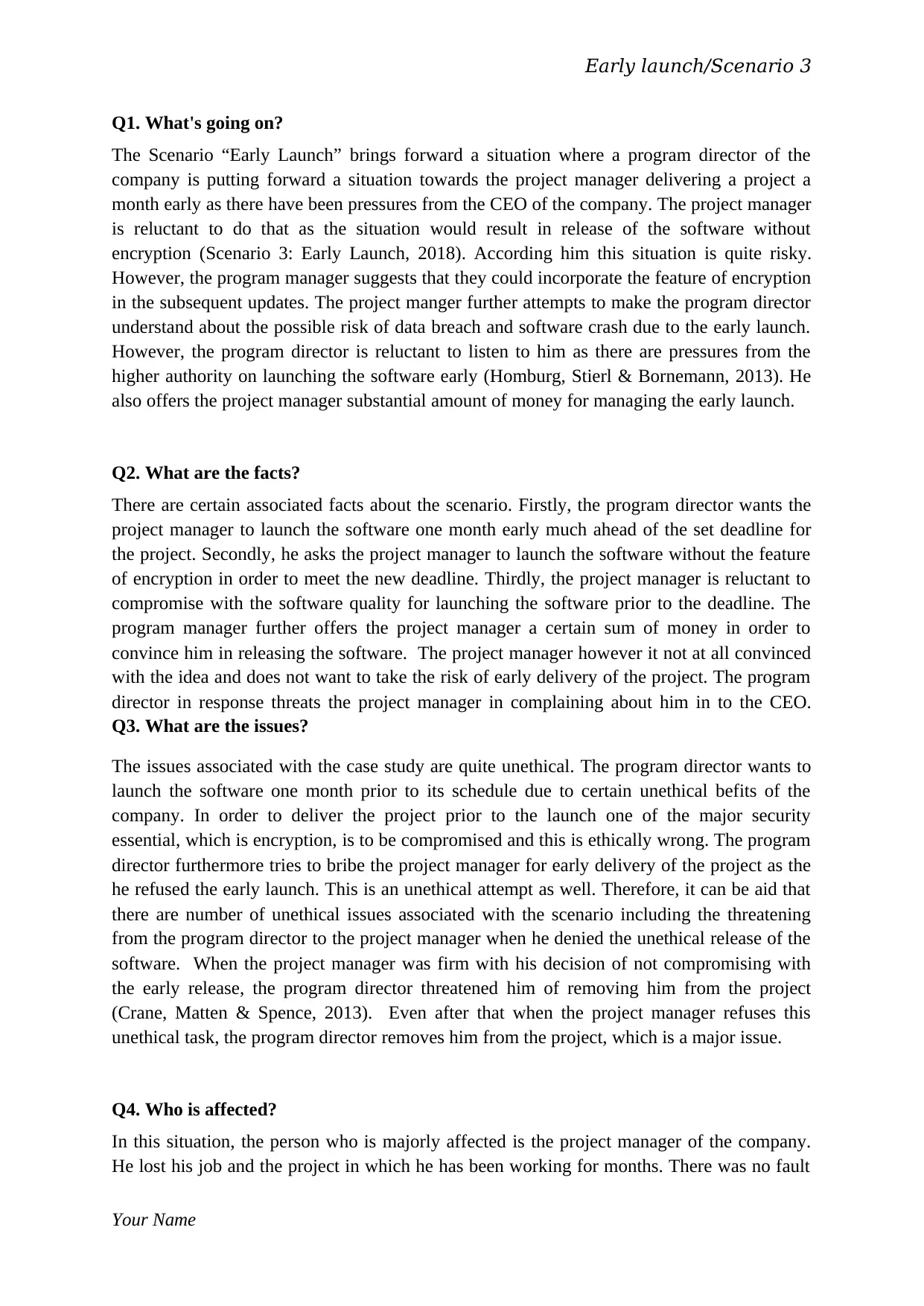
Early launch/Scenario 3
Q1. What's going on?
The Scenario “Early Launch” brings forward a situation where a program director of the
company is putting forward a situation towards the project manager delivering a project a
month early as there have been pressures from the CEO of the company. The project manager
is reluctant to do that as the situation would result in release of the software without
encryption (Scenario 3: Early Launch, 2018). According him this situation is quite risky.
However, the program manager suggests that they could incorporate the feature of encryption
in the subsequent updates. The project manger further attempts to make the program director
understand about the possible risk of data breach and software crash due to the early launch.
However, the program director is reluctant to listen to him as there are pressures from the
higher authority on launching the software early (Homburg, Stierl & Bornemann, 2013). He
also offers the project manager substantial amount of money for managing the early launch.
Q2. What are the facts?
There are certain associated facts about the scenario. Firstly, the program director wants the
project manager to launch the software one month early much ahead of the set deadline for
the project. Secondly, he asks the project manager to launch the software without the feature
of encryption in order to meet the new deadline. Thirdly, the project manager is reluctant to
compromise with the software quality for launching the software prior to the deadline. The
program manager further offers the project manager a certain sum of money in order to
convince him in releasing the software. The project manager however it not at all convinced
with the idea and does not want to take the risk of early delivery of the project. The program
director in response threats the project manager in complaining about him in to the CEO.
Q3. What are the issues?
The issues associated with the case study are quite unethical. The program director wants to
launch the software one month prior to its schedule due to certain unethical befits of the
company. In order to deliver the project prior to the launch one of the major security
essential, which is encryption, is to be compromised and this is ethically wrong. The program
director furthermore tries to bribe the project manager for early delivery of the project as the
he refused the early launch. This is an unethical attempt as well. Therefore, it can be aid that
there are number of unethical issues associated with the scenario including the threatening
from the program director to the project manager when he denied the unethical release of the
software. When the project manager was firm with his decision of not compromising with
the early release, the program director threatened him of removing him from the project
(Crane, Matten & Spence, 2013). Even after that when the project manager refuses this
unethical task, the program director removes him from the project, which is a major issue.
Q4. Who is affected?
In this situation, the person who is majorly affected is the project manager of the company.
He lost his job and the project in which he has been working for months. There was no fault
Your Name
Q1. What's going on?
The Scenario “Early Launch” brings forward a situation where a program director of the
company is putting forward a situation towards the project manager delivering a project a
month early as there have been pressures from the CEO of the company. The project manager
is reluctant to do that as the situation would result in release of the software without
encryption (Scenario 3: Early Launch, 2018). According him this situation is quite risky.
However, the program manager suggests that they could incorporate the feature of encryption
in the subsequent updates. The project manger further attempts to make the program director
understand about the possible risk of data breach and software crash due to the early launch.
However, the program director is reluctant to listen to him as there are pressures from the
higher authority on launching the software early (Homburg, Stierl & Bornemann, 2013). He
also offers the project manager substantial amount of money for managing the early launch.
Q2. What are the facts?
There are certain associated facts about the scenario. Firstly, the program director wants the
project manager to launch the software one month early much ahead of the set deadline for
the project. Secondly, he asks the project manager to launch the software without the feature
of encryption in order to meet the new deadline. Thirdly, the project manager is reluctant to
compromise with the software quality for launching the software prior to the deadline. The
program manager further offers the project manager a certain sum of money in order to
convince him in releasing the software. The project manager however it not at all convinced
with the idea and does not want to take the risk of early delivery of the project. The program
director in response threats the project manager in complaining about him in to the CEO.
Q3. What are the issues?
The issues associated with the case study are quite unethical. The program director wants to
launch the software one month prior to its schedule due to certain unethical befits of the
company. In order to deliver the project prior to the launch one of the major security
essential, which is encryption, is to be compromised and this is ethically wrong. The program
director furthermore tries to bribe the project manager for early delivery of the project as the
he refused the early launch. This is an unethical attempt as well. Therefore, it can be aid that
there are number of unethical issues associated with the scenario including the threatening
from the program director to the project manager when he denied the unethical release of the
software. When the project manager was firm with his decision of not compromising with
the early release, the program director threatened him of removing him from the project
(Crane, Matten & Spence, 2013). Even after that when the project manager refuses this
unethical task, the program director removes him from the project, which is a major issue.
Q4. Who is affected?
In this situation, the person who is majorly affected is the project manager of the company.
He lost his job and the project in which he has been working for months. There was no fault
Your Name
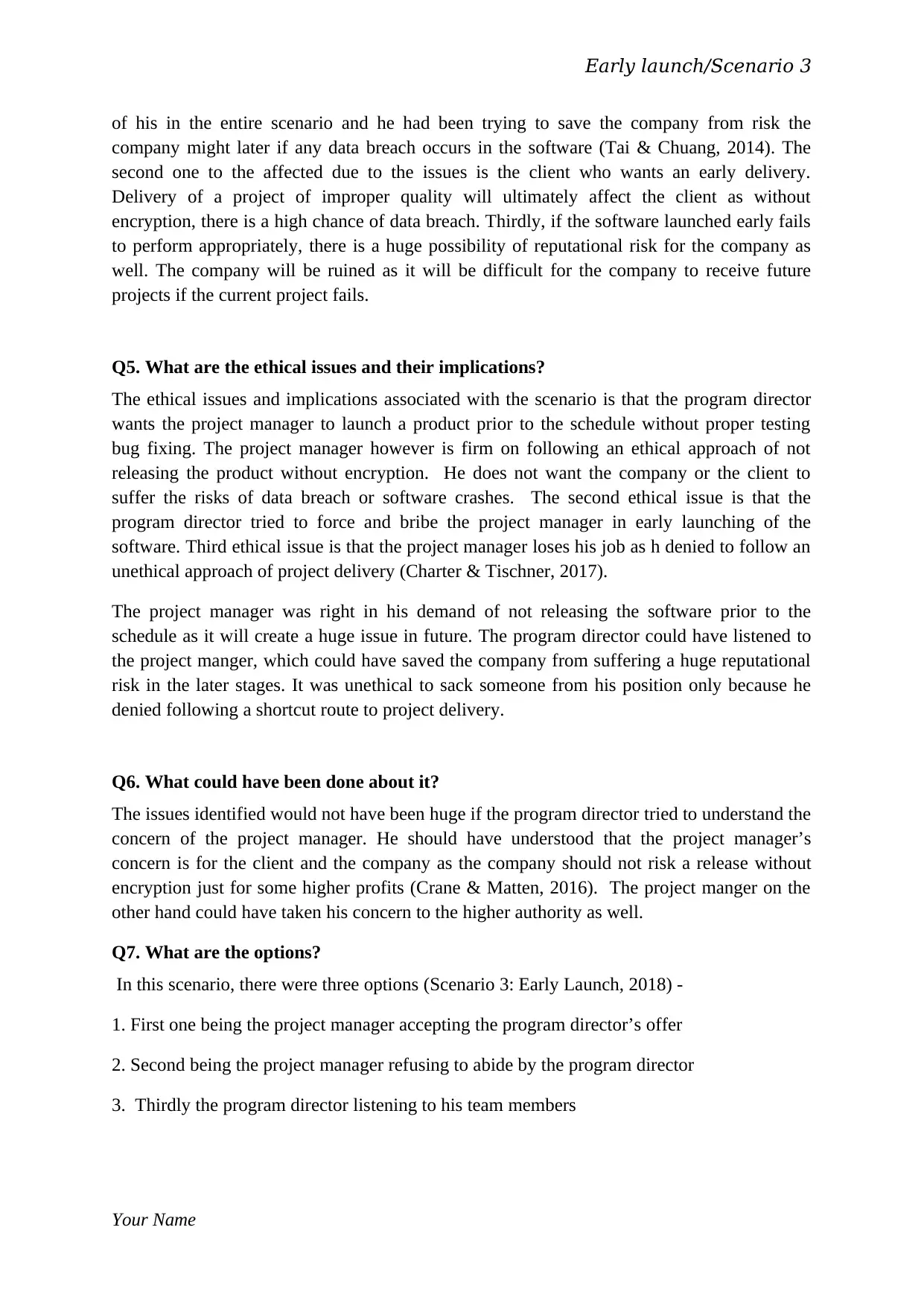
Early launch/Scenario 3
of his in the entire scenario and he had been trying to save the company from risk the
company might later if any data breach occurs in the software (Tai & Chuang, 2014). The
second one to the affected due to the issues is the client who wants an early delivery.
Delivery of a project of improper quality will ultimately affect the client as without
encryption, there is a high chance of data breach. Thirdly, if the software launched early fails
to perform appropriately, there is a huge possibility of reputational risk for the company as
well. The company will be ruined as it will be difficult for the company to receive future
projects if the current project fails.
Q5. What are the ethical issues and their implications?
The ethical issues and implications associated with the scenario is that the program director
wants the project manager to launch a product prior to the schedule without proper testing
bug fixing. The project manager however is firm on following an ethical approach of not
releasing the product without encryption. He does not want the company or the client to
suffer the risks of data breach or software crashes. The second ethical issue is that the
program director tried to force and bribe the project manager in early launching of the
software. Third ethical issue is that the project manager loses his job as h denied to follow an
unethical approach of project delivery (Charter & Tischner, 2017).
The project manager was right in his demand of not releasing the software prior to the
schedule as it will create a huge issue in future. The program director could have listened to
the project manger, which could have saved the company from suffering a huge reputational
risk in the later stages. It was unethical to sack someone from his position only because he
denied following a shortcut route to project delivery.
Q6. What could have been done about it?
The issues identified would not have been huge if the program director tried to understand the
concern of the project manager. He should have understood that the project manager’s
concern is for the client and the company as the company should not risk a release without
encryption just for some higher profits (Crane & Matten, 2016). The project manger on the
other hand could have taken his concern to the higher authority as well.
Q7. What are the options?
In this scenario, there were three options (Scenario 3: Early Launch, 2018) -
1. First one being the project manager accepting the program director’s offer
2. Second being the project manager refusing to abide by the program director
3. Thirdly the program director listening to his team members
Your Name
of his in the entire scenario and he had been trying to save the company from risk the
company might later if any data breach occurs in the software (Tai & Chuang, 2014). The
second one to the affected due to the issues is the client who wants an early delivery.
Delivery of a project of improper quality will ultimately affect the client as without
encryption, there is a high chance of data breach. Thirdly, if the software launched early fails
to perform appropriately, there is a huge possibility of reputational risk for the company as
well. The company will be ruined as it will be difficult for the company to receive future
projects if the current project fails.
Q5. What are the ethical issues and their implications?
The ethical issues and implications associated with the scenario is that the program director
wants the project manager to launch a product prior to the schedule without proper testing
bug fixing. The project manager however is firm on following an ethical approach of not
releasing the product without encryption. He does not want the company or the client to
suffer the risks of data breach or software crashes. The second ethical issue is that the
program director tried to force and bribe the project manager in early launching of the
software. Third ethical issue is that the project manager loses his job as h denied to follow an
unethical approach of project delivery (Charter & Tischner, 2017).
The project manager was right in his demand of not releasing the software prior to the
schedule as it will create a huge issue in future. The program director could have listened to
the project manger, which could have saved the company from suffering a huge reputational
risk in the later stages. It was unethical to sack someone from his position only because he
denied following a shortcut route to project delivery.
Q6. What could have been done about it?
The issues identified would not have been huge if the program director tried to understand the
concern of the project manager. He should have understood that the project manager’s
concern is for the client and the company as the company should not risk a release without
encryption just for some higher profits (Crane & Matten, 2016). The project manger on the
other hand could have taken his concern to the higher authority as well.
Q7. What are the options?
In this scenario, there were three options (Scenario 3: Early Launch, 2018) -
1. First one being the project manager accepting the program director’s offer
2. Second being the project manager refusing to abide by the program director
3. Thirdly the program director listening to his team members
Your Name
⊘ This is a preview!⊘
Do you want full access?
Subscribe today to unlock all pages.

Trusted by 1+ million students worldwide
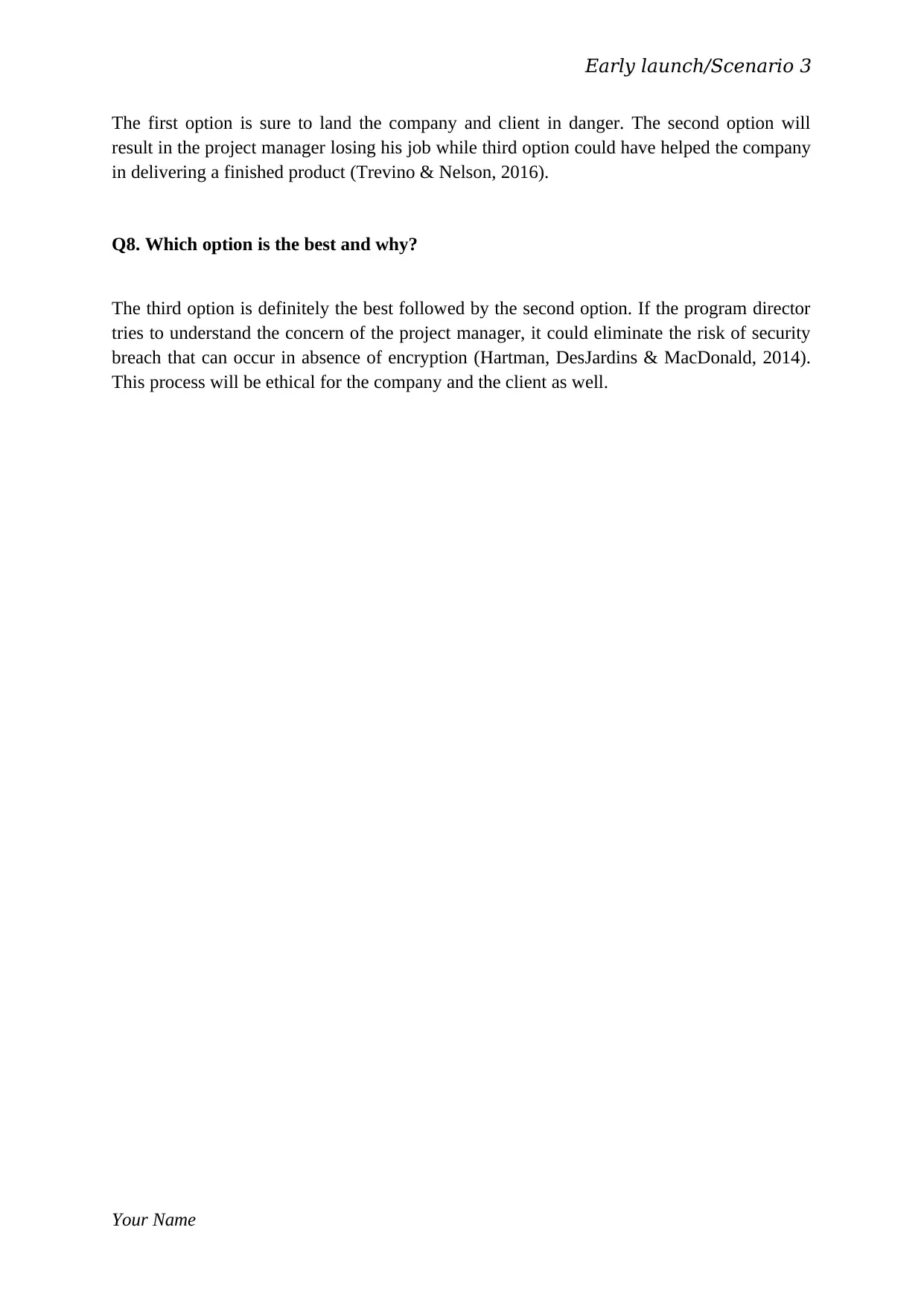
Early launch/Scenario 3
The first option is sure to land the company and client in danger. The second option will
result in the project manager losing his job while third option could have helped the company
in delivering a finished product (Trevino & Nelson, 2016).
Q8. Which option is the best and why?
The third option is definitely the best followed by the second option. If the program director
tries to understand the concern of the project manager, it could eliminate the risk of security
breach that can occur in absence of encryption (Hartman, DesJardins & MacDonald, 2014).
This process will be ethical for the company and the client as well.
Your Name
The first option is sure to land the company and client in danger. The second option will
result in the project manager losing his job while third option could have helped the company
in delivering a finished product (Trevino & Nelson, 2016).
Q8. Which option is the best and why?
The third option is definitely the best followed by the second option. If the program director
tries to understand the concern of the project manager, it could eliminate the risk of security
breach that can occur in absence of encryption (Hartman, DesJardins & MacDonald, 2014).
This process will be ethical for the company and the client as well.
Your Name
Paraphrase This Document
Need a fresh take? Get an instant paraphrase of this document with our AI Paraphraser
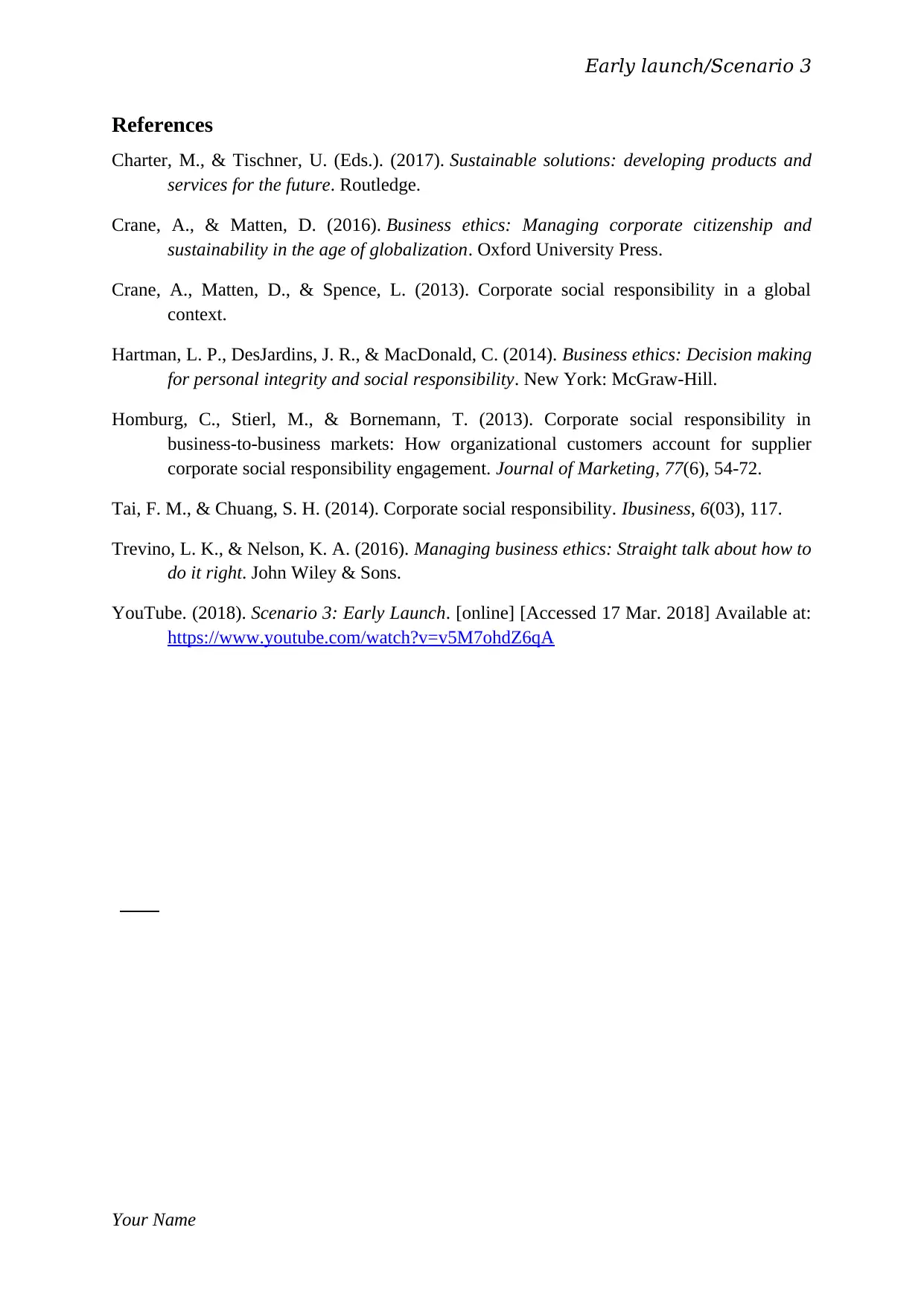
Early launch/Scenario 3
References
Charter, M., & Tischner, U. (Eds.). (2017). Sustainable solutions: developing products and
services for the future. Routledge.
Crane, A., & Matten, D. (2016). Business ethics: Managing corporate citizenship and
sustainability in the age of globalization. Oxford University Press.
Crane, A., Matten, D., & Spence, L. (2013). Corporate social responsibility in a global
context.
Hartman, L. P., DesJardins, J. R., & MacDonald, C. (2014). Business ethics: Decision making
for personal integrity and social responsibility. New York: McGraw-Hill.
Homburg, C., Stierl, M., & Bornemann, T. (2013). Corporate social responsibility in
business-to-business markets: How organizational customers account for supplier
corporate social responsibility engagement. Journal of Marketing, 77(6), 54-72.
Tai, F. M., & Chuang, S. H. (2014). Corporate social responsibility. Ibusiness, 6(03), 117.
Trevino, L. K., & Nelson, K. A. (2016). Managing business ethics: Straight talk about how to
do it right. John Wiley & Sons.
YouTube. (2018). Scenario 3: Early Launch. [online] [Accessed 17 Mar. 2018] Available at:
https://www.youtube.com/watch?v=v5M7ohdZ6qA
Your Name
References
Charter, M., & Tischner, U. (Eds.). (2017). Sustainable solutions: developing products and
services for the future. Routledge.
Crane, A., & Matten, D. (2016). Business ethics: Managing corporate citizenship and
sustainability in the age of globalization. Oxford University Press.
Crane, A., Matten, D., & Spence, L. (2013). Corporate social responsibility in a global
context.
Hartman, L. P., DesJardins, J. R., & MacDonald, C. (2014). Business ethics: Decision making
for personal integrity and social responsibility. New York: McGraw-Hill.
Homburg, C., Stierl, M., & Bornemann, T. (2013). Corporate social responsibility in
business-to-business markets: How organizational customers account for supplier
corporate social responsibility engagement. Journal of Marketing, 77(6), 54-72.
Tai, F. M., & Chuang, S. H. (2014). Corporate social responsibility. Ibusiness, 6(03), 117.
Trevino, L. K., & Nelson, K. A. (2016). Managing business ethics: Straight talk about how to
do it right. John Wiley & Sons.
YouTube. (2018). Scenario 3: Early Launch. [online] [Accessed 17 Mar. 2018] Available at:
https://www.youtube.com/watch?v=v5M7ohdZ6qA
Your Name
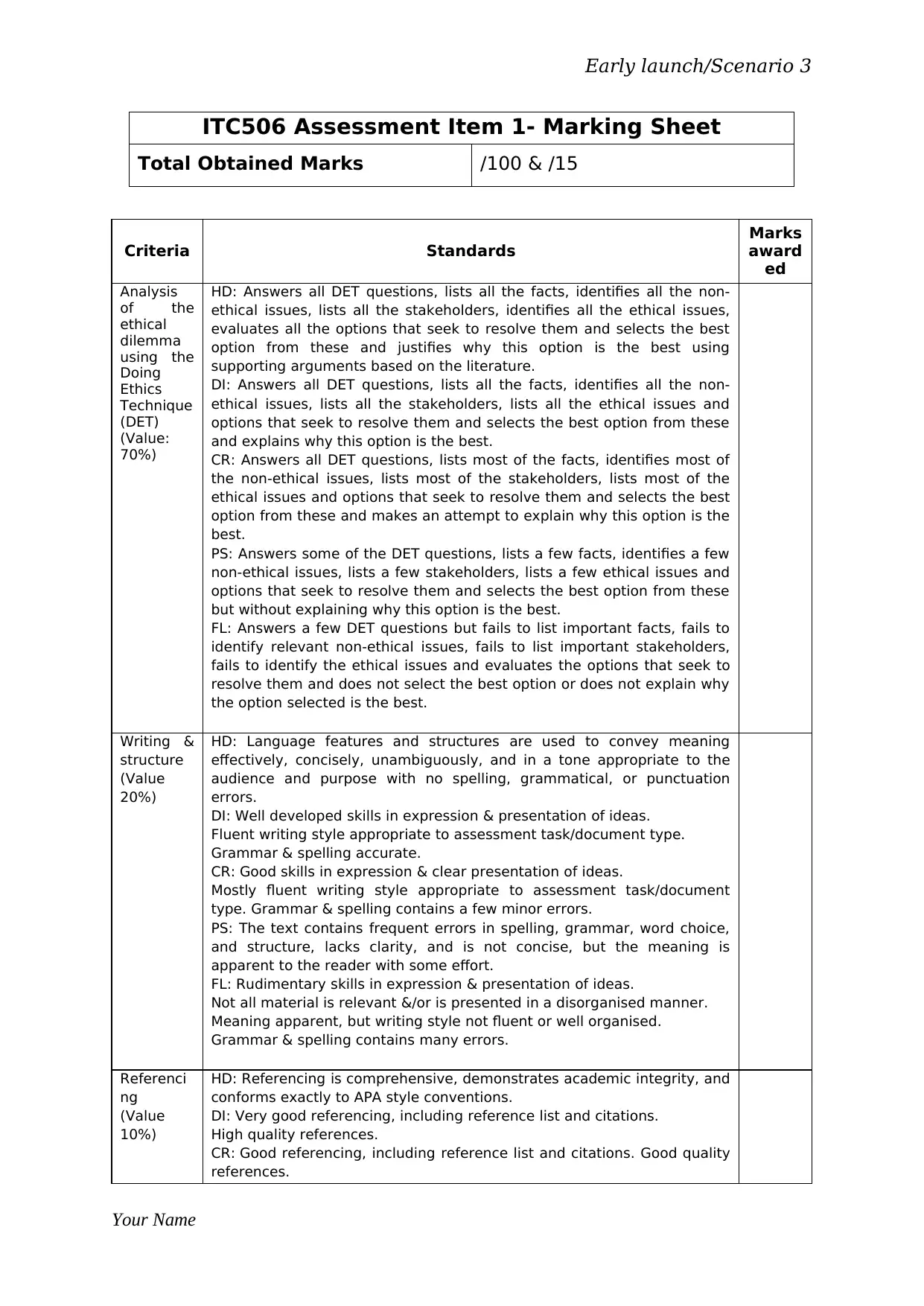
Early launch/Scenario 3
ITC506 Assessment Item 1- Marking Sheet
Total Obtained Marks /100 & /15
Criteria Standards
Marks
award
ed
Analysis
of the
ethical
dilemma
using the
Doing
Ethics
Technique
(DET)
(Value:
70%)
HD: Answers all DET questions, lists all the facts, identifies all the non-
ethical issues, lists all the stakeholders, identifies all the ethical issues,
evaluates all the options that seek to resolve them and selects the best
option from these and justifies why this option is the best using
supporting arguments based on the literature.
DI: Answers all DET questions, lists all the facts, identifies all the non-
ethical issues, lists all the stakeholders, lists all the ethical issues and
options that seek to resolve them and selects the best option from these
and explains why this option is the best.
CR: Answers all DET questions, lists most of the facts, identifies most of
the non-ethical issues, lists most of the stakeholders, lists most of the
ethical issues and options that seek to resolve them and selects the best
option from these and makes an attempt to explain why this option is the
best.
PS: Answers some of the DET questions, lists a few facts, identifies a few
non-ethical issues, lists a few stakeholders, lists a few ethical issues and
options that seek to resolve them and selects the best option from these
but without explaining why this option is the best.
FL: Answers a few DET questions but fails to list important facts, fails to
identify relevant non-ethical issues, fails to list important stakeholders,
fails to identify the ethical issues and evaluates the options that seek to
resolve them and does not select the best option or does not explain why
the option selected is the best.
Writing &
structure
(Value
20%)
HD: Language features and structures are used to convey meaning
effectively, concisely, unambiguously, and in a tone appropriate to the
audience and purpose with no spelling, grammatical, or punctuation
errors.
DI: Well developed skills in expression & presentation of ideas.
Fluent writing style appropriate to assessment task/document type.
Grammar & spelling accurate.
CR: Good skills in expression & clear presentation of ideas.
Mostly fluent writing style appropriate to assessment task/document
type. Grammar & spelling contains a few minor errors.
PS: The text contains frequent errors in spelling, grammar, word choice,
and structure, lacks clarity, and is not concise, but the meaning is
apparent to the reader with some effort.
FL: Rudimentary skills in expression & presentation of ideas.
Not all material is relevant &/or is presented in a disorganised manner.
Meaning apparent, but writing style not fluent or well organised.
Grammar & spelling contains many errors.
Referenci
ng
(Value
10%)
HD: Referencing is comprehensive, demonstrates academic integrity, and
conforms exactly to APA style conventions.
DI: Very good referencing, including reference list and citations.
High quality references.
CR: Good referencing, including reference list and citations. Good quality
references.
Your Name
ITC506 Assessment Item 1- Marking Sheet
Total Obtained Marks /100 & /15
Criteria Standards
Marks
award
ed
Analysis
of the
ethical
dilemma
using the
Doing
Ethics
Technique
(DET)
(Value:
70%)
HD: Answers all DET questions, lists all the facts, identifies all the non-
ethical issues, lists all the stakeholders, identifies all the ethical issues,
evaluates all the options that seek to resolve them and selects the best
option from these and justifies why this option is the best using
supporting arguments based on the literature.
DI: Answers all DET questions, lists all the facts, identifies all the non-
ethical issues, lists all the stakeholders, lists all the ethical issues and
options that seek to resolve them and selects the best option from these
and explains why this option is the best.
CR: Answers all DET questions, lists most of the facts, identifies most of
the non-ethical issues, lists most of the stakeholders, lists most of the
ethical issues and options that seek to resolve them and selects the best
option from these and makes an attempt to explain why this option is the
best.
PS: Answers some of the DET questions, lists a few facts, identifies a few
non-ethical issues, lists a few stakeholders, lists a few ethical issues and
options that seek to resolve them and selects the best option from these
but without explaining why this option is the best.
FL: Answers a few DET questions but fails to list important facts, fails to
identify relevant non-ethical issues, fails to list important stakeholders,
fails to identify the ethical issues and evaluates the options that seek to
resolve them and does not select the best option or does not explain why
the option selected is the best.
Writing &
structure
(Value
20%)
HD: Language features and structures are used to convey meaning
effectively, concisely, unambiguously, and in a tone appropriate to the
audience and purpose with no spelling, grammatical, or punctuation
errors.
DI: Well developed skills in expression & presentation of ideas.
Fluent writing style appropriate to assessment task/document type.
Grammar & spelling accurate.
CR: Good skills in expression & clear presentation of ideas.
Mostly fluent writing style appropriate to assessment task/document
type. Grammar & spelling contains a few minor errors.
PS: The text contains frequent errors in spelling, grammar, word choice,
and structure, lacks clarity, and is not concise, but the meaning is
apparent to the reader with some effort.
FL: Rudimentary skills in expression & presentation of ideas.
Not all material is relevant &/or is presented in a disorganised manner.
Meaning apparent, but writing style not fluent or well organised.
Grammar & spelling contains many errors.
Referenci
ng
(Value
10%)
HD: Referencing is comprehensive, demonstrates academic integrity, and
conforms exactly to APA style conventions.
DI: Very good referencing, including reference list and citations.
High quality references.
CR: Good referencing, including reference list and citations. Good quality
references.
Your Name
⊘ This is a preview!⊘
Do you want full access?
Subscribe today to unlock all pages.

Trusted by 1+ million students worldwide
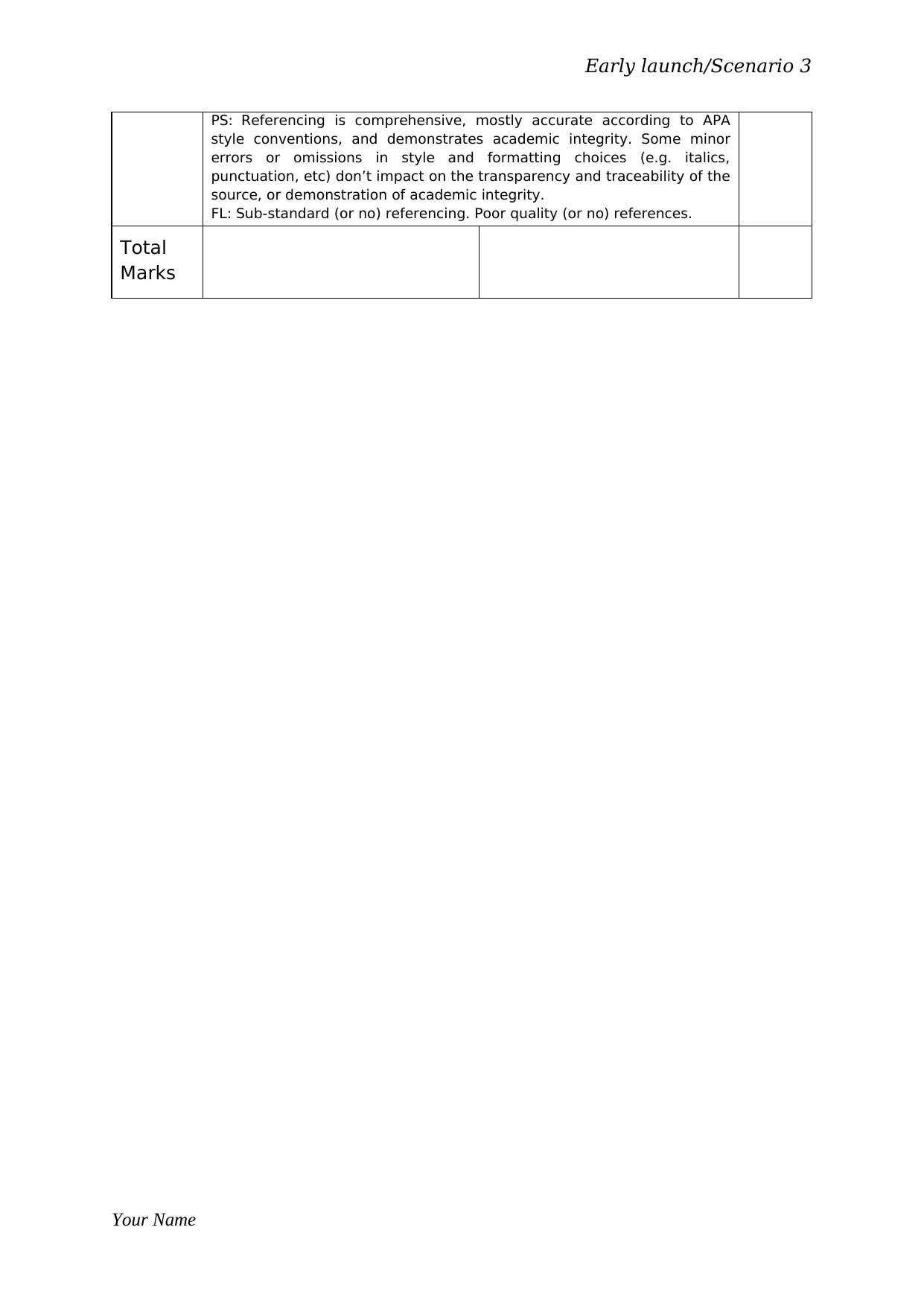
Early launch/Scenario 3
PS: Referencing is comprehensive, mostly accurate according to APA
style conventions, and demonstrates academic integrity. Some minor
errors or omissions in style and formatting choices (e.g. italics,
punctuation, etc) don’t impact on the transparency and traceability of the
source, or demonstration of academic integrity.
FL: Sub-standard (or no) referencing. Poor quality (or no) references.
Total
Marks
Your Name
PS: Referencing is comprehensive, mostly accurate according to APA
style conventions, and demonstrates academic integrity. Some minor
errors or omissions in style and formatting choices (e.g. italics,
punctuation, etc) don’t impact on the transparency and traceability of the
source, or demonstration of academic integrity.
FL: Sub-standard (or no) referencing. Poor quality (or no) references.
Total
Marks
Your Name
1 out of 7
Related Documents
Your All-in-One AI-Powered Toolkit for Academic Success.
+13062052269
info@desklib.com
Available 24*7 on WhatsApp / Email
![[object Object]](/_next/static/media/star-bottom.7253800d.svg)
Unlock your academic potential
Copyright © 2020–2025 A2Z Services. All Rights Reserved. Developed and managed by ZUCOL.





